Solid Swing – Essential Lessons
by Johnathon Yarwood
While we can perhaps excuse tour players for wanting to explore their technique in some detail, it is my contention that the majority of amateur golfers generally do themselves more harm than good when it comes to the pursuit of detailed information which, ultimately, they simply do not need.
Good golf is natural golf – and if you follow a few basic rules you will discover that this game need not be as complicated as you think.What’s more, you will play better golf the more simply you think about what you are doing.
Now I’ve stuck my neck on the line, let me give you a crash course in the essential skills you need to go out and make a solid swing.
Solid Swing – Essential Lessons
Fitting the left hand: Low in the fingers will help to free up the ‘hinge’
Good golf begins with a good grip, and in order to maximise your potential for creating clubhead speed, you need a grip that is capable of conducting and multiplying the centrifugal forces created by the body in the process of making a free-flowing swing. The grip is the conduit – the necessary go between that allows the transfer of energy down through the shaft and into the clubhead.
When it comes to fitting the left hand, the danger is that you run the grip too high through the palm of the hand, which can lead to a massive loss of mobility in the left wrist. So, as you lay the club into the left hand,make sure that the grip sits low in the fingers, from the base of the little finger through to the first joint on the forefinger (1). Your left thumb should sit just to the right of the centre line as you look down, the V between thumb and forefinger pointing up between your chin and right shoulder (2).
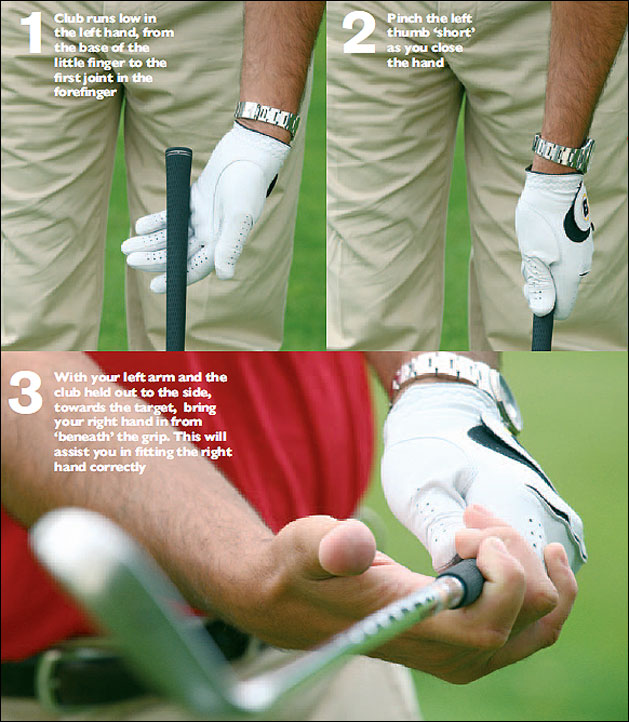
2. Pinch the left thumb ‘short’ as you close the hand
3. With your left arm and the club held out to the side, towards the target, bring your right hand in from ‘beneath’ the grip. This will assist you in fitting the right hand correctly
Solid Swing – Essential Lessons
Picture 3 reveals a useful trick when it comes the left thumb to fitting the right hand. With my left hand on the grip, I have raised the club out to my left, toward the target, which then means that my right hand is forced to swing across and ‘under’ to assume its position on the grip. Again, it’s important that the grip fits low in the fingers of the right hand (4), while the thumb and forefinger engage to provide the ‘trigger’ unit (which rewards you with a terrific sense of feel). With an even grip pressure, the two hands are ready to work together as a unit, enabling you to get speed in the shaft and – ultimately – into the ball.
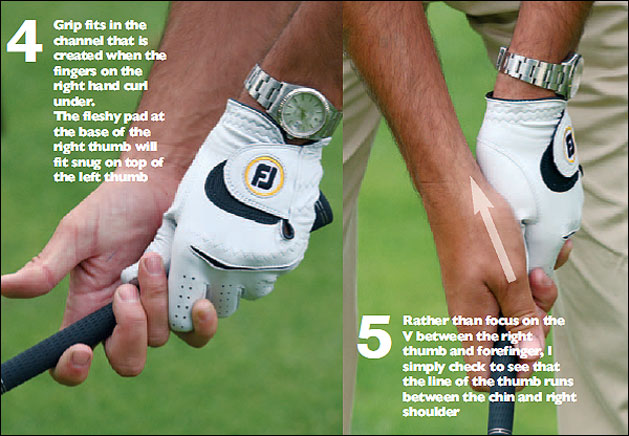
5. Rather than focus on the V between the right thumb and forefinger, I simply check to see that the line of the thumb runs between the chin and right shoulder
Solid Swing – Essential Lessons
The Set Up: How to create good angles in a ready, ‘athletic’ posture
One of the reasons good players make generating speed and power look so easy is that they understand the importance of being ‘grounded’. With a stable platform, and with their posture balanced on the balls of their feet, they use the ground to help them wind and unwind their body.
One way to get a sense of this type of athleticism as you assume your posture is to stand a club on end and use it as a support as you flex your knees and bend gently from the hips to create the body angles that you need in order to make a good swing. Placing a club or a piece of 4” x 2”on the ground will guarantee good alignment of the feet, knees, hips and shoulders.
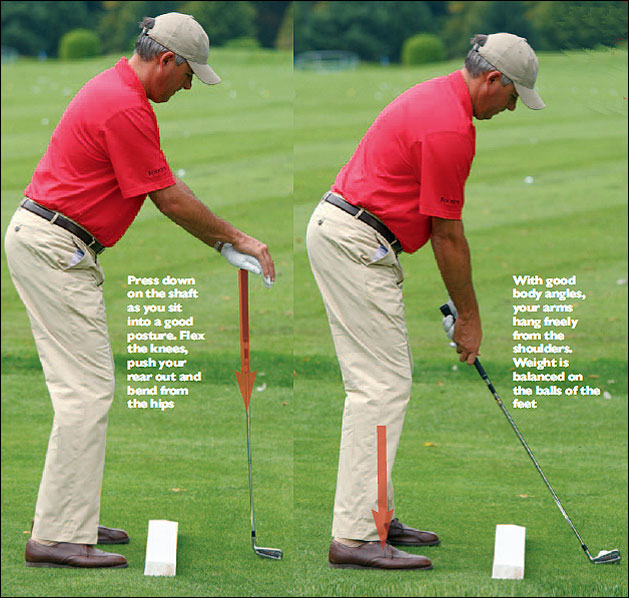
With good body angles, your arms hang freely from the shoulders. Weight is balanced on the balls of the feet
Solid Swing – Essential Lessons
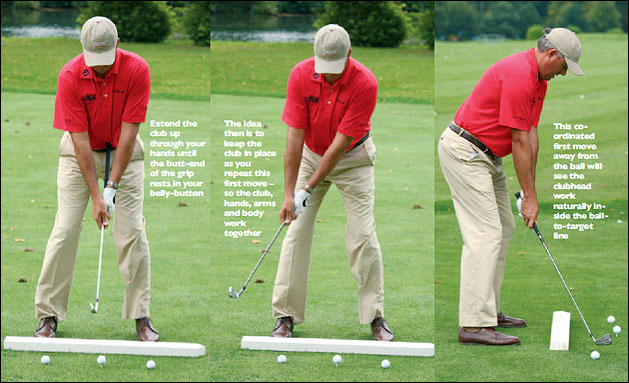
The idea then is to keep the club in place as you repeat this first move – so the club, hands, arms and body work together
This co-ordinated first move away from the ball will see the clubhead work naturally inside the ball-to-target line
Solid Swing – Essential Lessons
The ‘L-to-L’ Drill: Your quickest route to honing a co-ordinated swing
If you are serious about the way you practice, go out and get yourself a piece of 4” x 2” and use it as a source of reference when you work on your game. It is invaluable in keeping you aware of your target line.
The ‘L-to-L’ drill will very quickly help you to harmonise the hingeing of the wrists with the turning of the body – and thus develop the heart of a good golf swing. If you can find time to hit balls like this for 20 minutes just once a week you will experience a big improvement in the shape of your swing and the quality of your ball-striking
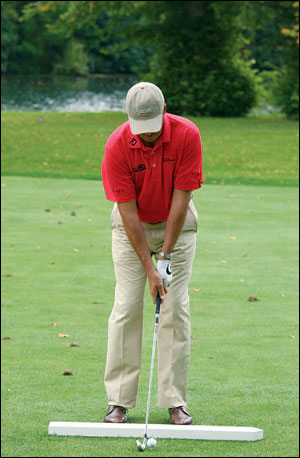
To maximise the benefits of this exercise, stand with your feet no further apart than this. Use a 7- iron and tee the ball up
Solid Swing – Essential Lessons

Blending your armswing with body turn, hinge your wrists to get the club into this halfway back position
Solid Swing – Essential Lessons
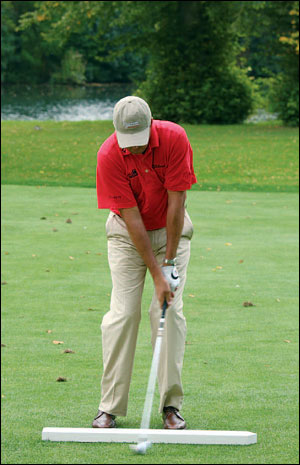
Smooth and unhurried, unwind to ‘collect’ the ball off the peg. There is no need to hit ‘at’ the ball; simply let it get in the way as you swing the clubhead
Solid Swing – Essential Lessons
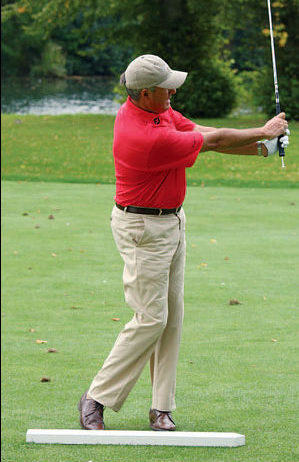
This crossover of the forearms and wrists is a key feature of a good swing. The right arm straightens as the club is released and the wrists hinge the club up on its way to the finish
Solid Swing – Essential Lessons

Solid Swing – Essential Lessons
How to set your swing in motion
‘Snatching’ the club away from the ball,or jerking it back with the hands, are among the most common faults in golf.They immediately destroy any hope of a smooth chain-reaction from start tofinish.What you need to understand is that the seeds to a good swing are sown in the first move – and the key is that you set the club in motion with the shoulders, arms and hands working together in harmony.
Extending the butt-end of the club up into your belly-button, as I am demonstrating here, creates a good drill to simply rehearse and get a feeling for this ‘connection’.
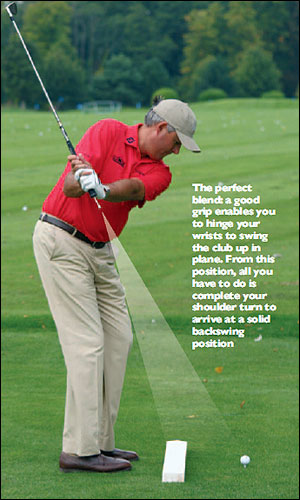
From this position all you have to do is complete your shoulder turn to arrive at a solid backswing position
Solid Swing – Essential Lessons
Simplifying swing plane: Use this checkpoint to keep on track
A lot of golfers get confused about swing plane, so let’s simplify the issue. When you check your swing on a video,or on your telephone, you want to see the shaft plane fall some where within the area we have shaded here-a cone of safety.We are all different height and build,but as long as your club shaft points within this shaded area at this key halfway back checkpoint, you have the club swinging on a good plane.
Putting it all together: How to blend body-pivot and arm swing
OK, so let’s summarise the lesson so far. You now have the basics of a good working grip, one that enables the wrists to hinge and ‘set’ correctly in the swing, you understand that a good first move sees the arms, hands and the club work away from the ball ‘together’ and in harmony with your body ‘centre’, and -with the help of the ‘L-to-L’ drill, you have a sense of the way a good wrist hinge sort of provides the ‘oil’ that gels the whole motion together with a swinging rhythm. Now let’s complete the body action.
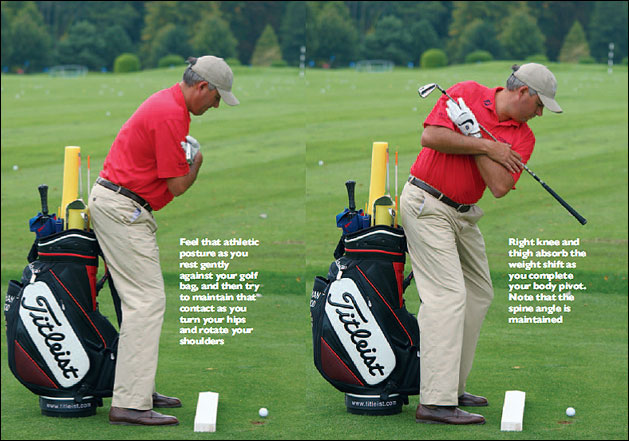
Right knee and thigh absorb the weight shift as you complete your body pivot. Note that the spine angle is maintained
Solid Swing – Essential Lessons
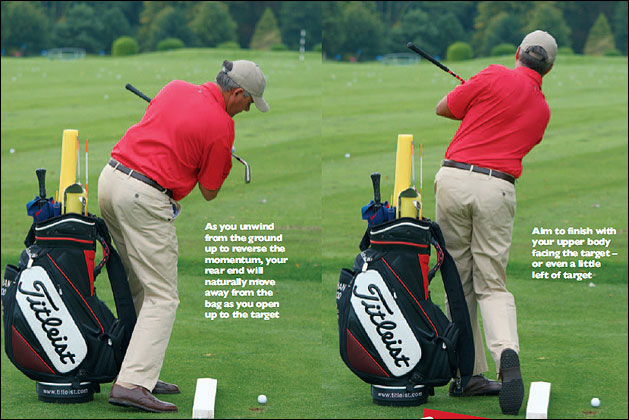
Aim to finish with your upper body facing the target – or even a little left of target
Solid Swing – Essential Lessons
The drill you see above – the basic pivot drill – will simply help you to appreciate the role of the bigger muscles in the body when it comes to turning first away from and then towards the target. Think of this body action as the framework that governs a solid, repeating swing. The arms, hands and the club go along for the ride, while your grip transfers the centrifugal forces generated by the rotation of your body down through the clubshaft and into the clubhead.
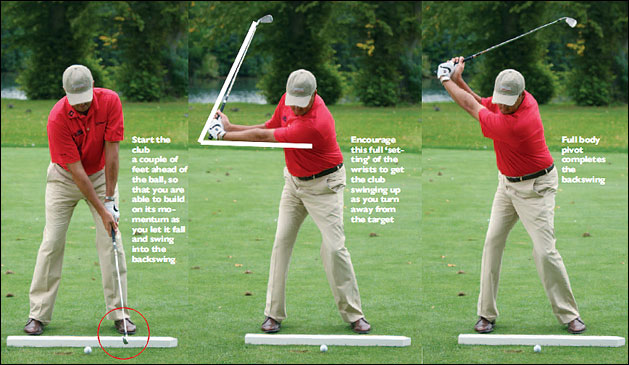
Encourage this full ‘setting’ of the wrists to get the club swinging up as you turn away from the target
Full body pivot completes the backswing
Solid Swing – Essential Lessons
Alternating between the L-to-L drill, the pivot drill and this full-swing exercise will help you to combine all of the elements that go together to produce a good golf swing. Ideally, I would suggest spending five minutes hitting balls working on the L-to-L drill, then a couple of minutes rehearsing the body pivot (in slow motion to really ingrain the feelings of turning and unwinding properly) and then a further five minutes on this full-swing routine.
Focus on the rhythm and the timing of your swing so that you plant the clubhead squarely on the back of the ball for solid striking. ‘Collect’ the ball as you unwind and free-wheel to a full, balanced finish
How to feel a better rhythm and up your clubhead speed
Take a mid iron in your right hand (or left if you are a left-handed player) and make this ‘pencil’ grip between the thumb and forefinger. This will give you a terrific sense of feel for the weight of the clubhead, while the ‘looseness’ of the grip will see to it that you are unable to ‘over-control’ the movement of the club – which results in you developing a real sense of building up clubhead speed with a natural swinging action.

Solid Swing – Essential Lessons
1 – In a good posture, the right hand takes the ‘pencil’ grip, while the left is placed on the sternum- your swing ‘centre’
2 – Feel your body ‘centre’, arm and club move away together. The clubhead stays low to the ground for the first few feet of its journey
3 – Body continues to rotate, while the right arm swings freely away and up as clubhead gathers momentum
4 – As you near the top of the backswing, you are at the same time in the process of preparing to start down. Like cracking a whip, this recoil effect creates clubhead ‘lag’ as the wrist loads…

Solid Swing – Essential Lessons
5 – … and the result of that ‘lag’ is a significant rate of acceleration into the downswing
6 – Upper body is now unwinding hard, creating the centrifugal force that speeds the and and the clubhead
7 – Wrist has delayed in releasing for as long as possible but now the force is irresistible and the final ‘whip’ is applied through impact area
8 – All of the energy that has been created in the swing is released down the line towards the target
9 – Body rotates all the way to a full finish, the right shoulder pointing to the target, clubshaft up and over the left shoulder